高中英语五种基本句型课件(51张PPT)
图片预览

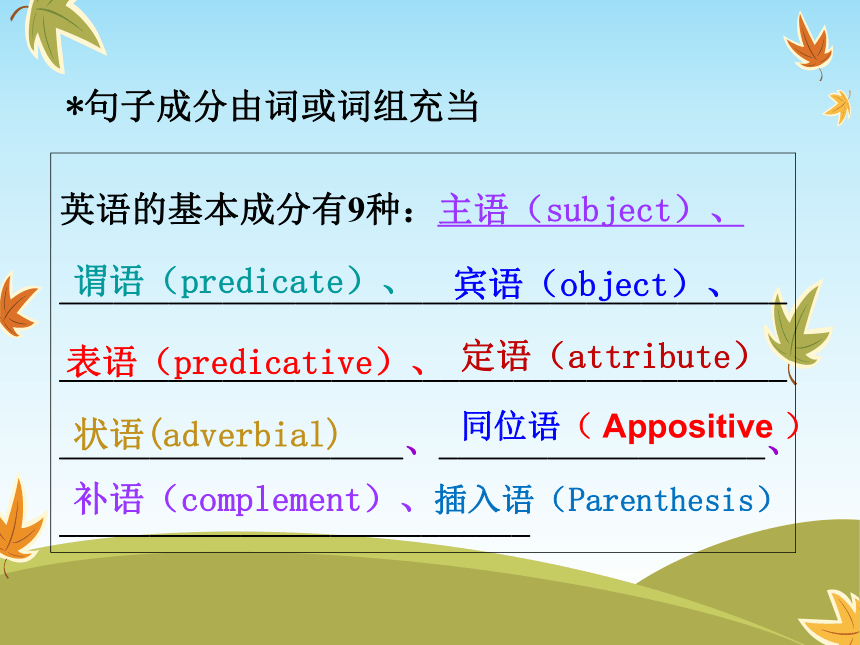

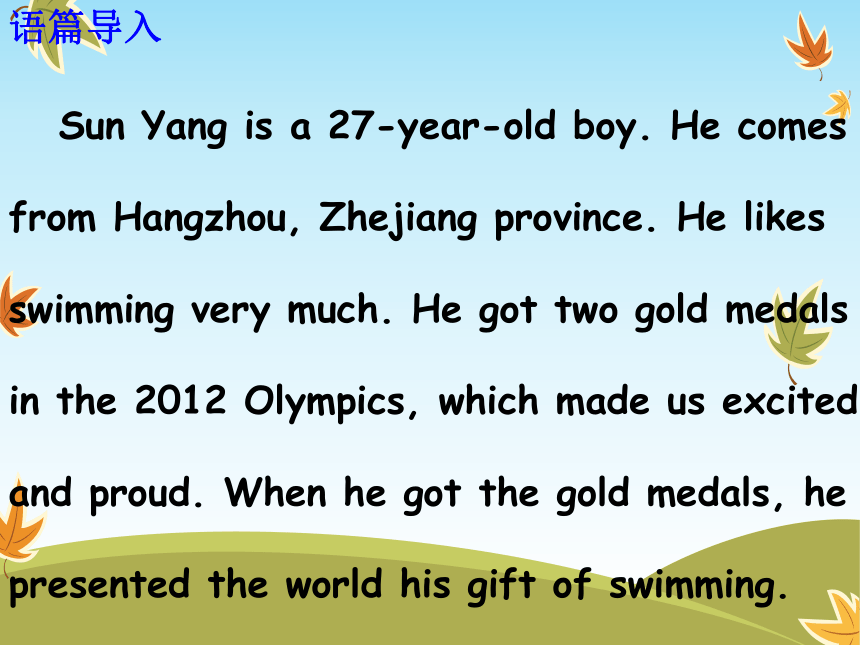
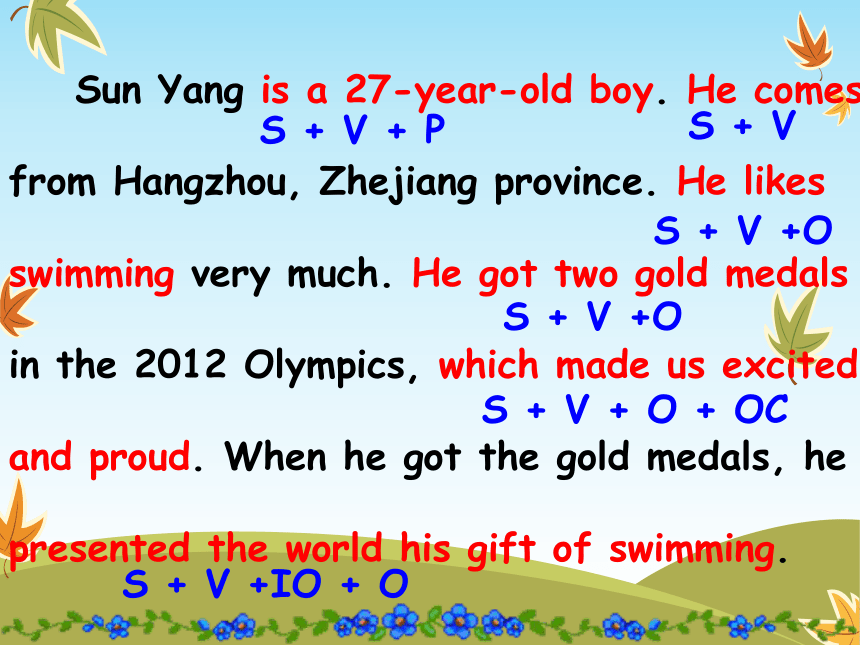
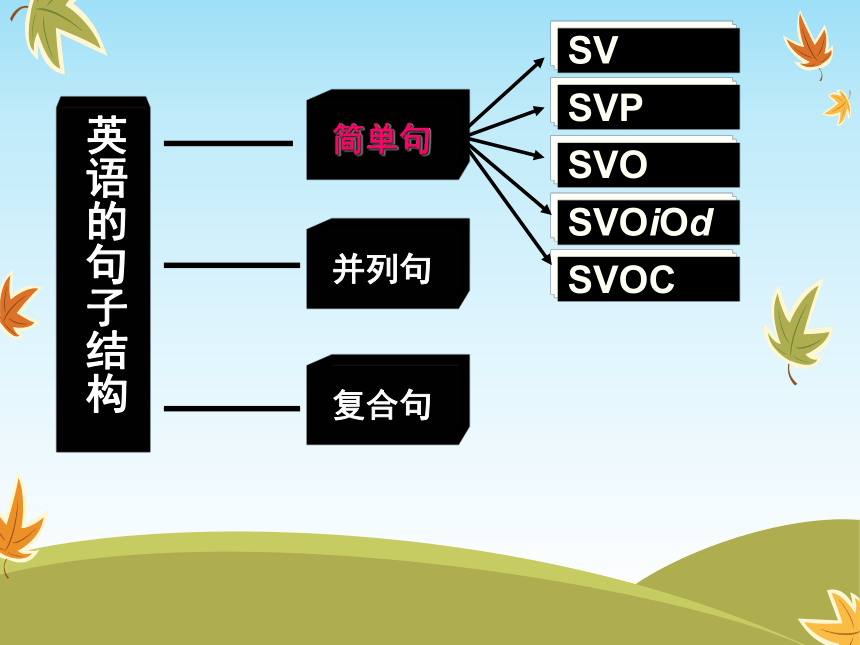

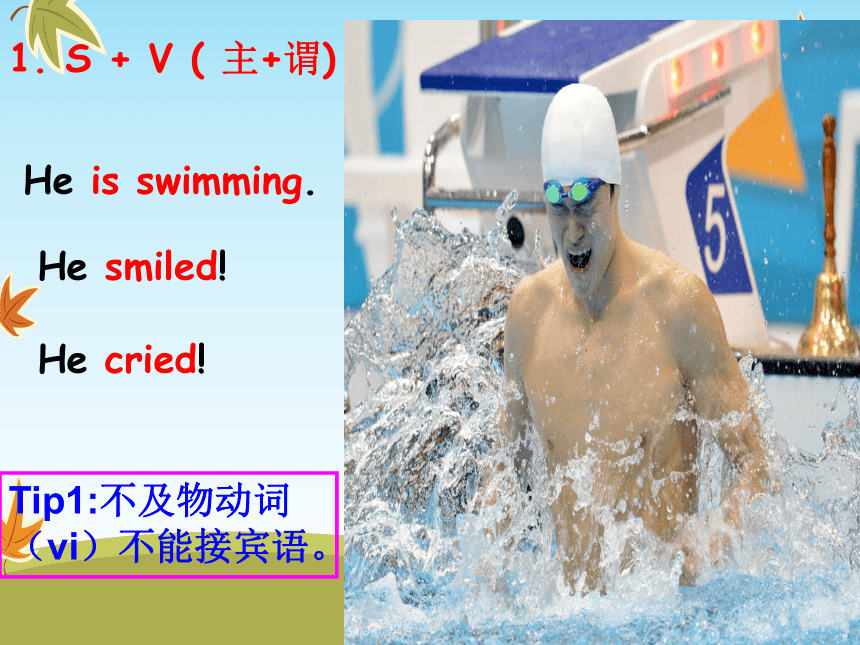
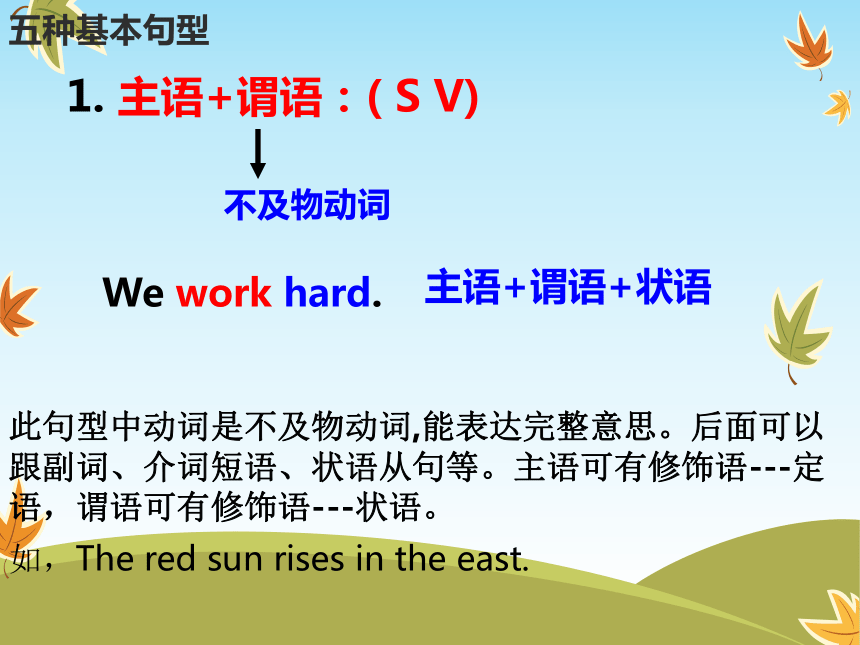
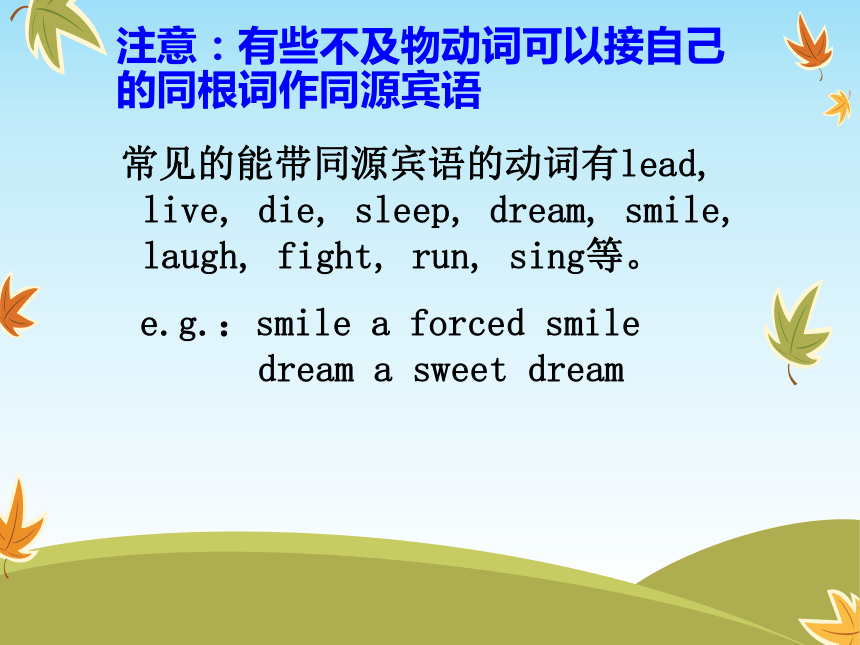
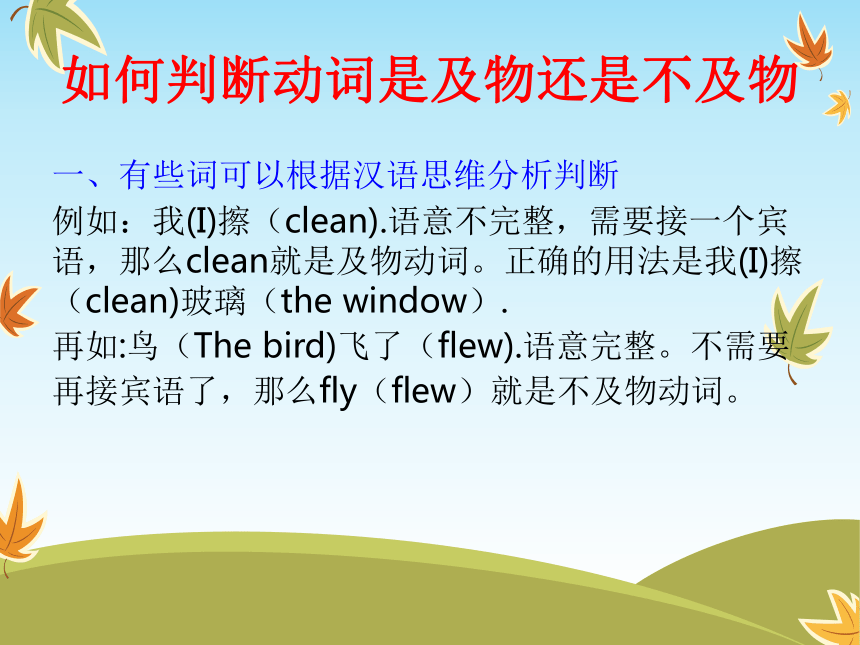
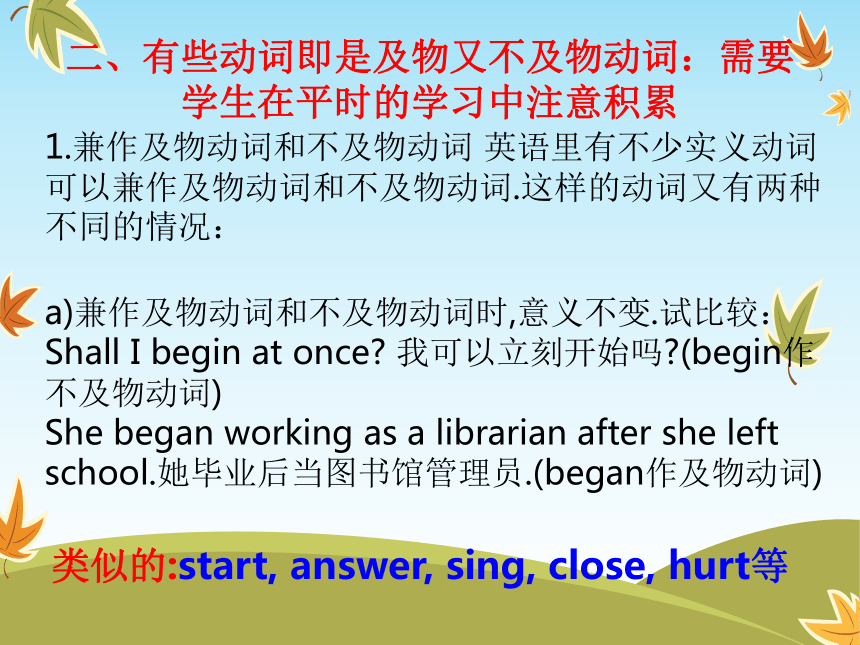
文档简介
课件51张PPT。英 语 五 种 基 本 句 型
*句子成分由词或词组充当英语的基本成分有9种:主语(subject)、
___________________________________________________________________________________________________、__________________、__________________________谓语(predicate)、表语(predicative)、宾语(object)、定语(attribute)状语(adverbial)补语(complement)、插入语(Parenthesis)同位语( Appositive ) Sun Yang is a 27-year-old boy. He comes
from Hangzhou, Zhejiang province. He likes
swimming very much. He got two gold medals
in the 2012 Olympics, which made us excited and proud. When he got the gold medals, he presented the world his gift of swimming.语篇导入 Sun Yang is a 27-year-old boy. He comes
from Hangzhou, Zhejiang province. He likes
swimming very much. He got two gold medals
in the 2012 Olympics, which made us excited
and proud. When he got the gold medals, he
presented the world his gift of swimming.S + V + PS + VS + V +OS + V + O + OCS + V +IO + OS + V +O英语的句子结构简单句并列句复合句简单句SVSVPSVOSVOiOdSVOC 英语句子长短简繁不一,表面上似乎难以捉摸,但可以从实质上发现其内在联系,找出其共同规律。即可以归纳成五种基本句型及其扩大、组合、省略或倒装。掌握这五种基本句型,是掌握各种英语句子结构的基础。 基本句型一:S +V (主+谓)
基本句型二:S +V +P (主+谓/系+表)
基本句型三:S +V +O (主+谓+宾)
基本句型四: S +V +InO +DO(主+谓+间宾+直宾)
基本句型五: S +V +O +OC(主+谓+宾+宾补)1. S + V ( 主+谓)He is swimming.He smiled!Tip1:不及物动词(vi)不能接宾语。He cried!五种基本句型1. 主语+谓语:( S V)不及物动词We work hard.主语+谓语+状语此句型中动词是不及物动词,能表达完整意思。后面可以跟副词、介词短语、状语从句等。主语可有修饰语---定语,谓语可有修饰语---状语。
如,The red sun rises in the east.注意:有些不及物动词可以接自己的同根词作同源宾语常见的能带同源宾语的动词有lead, live, die, sleep, dream, smile, laugh, fight, run, sing等。
e.g.:smile a forced smile dream a sweet dream一、有些词可以根据汉语思维分析判断
例如:我(I)擦(clean).语意不完整,需要接一个宾语,那么clean就是及物动词。正确的用法是我(I)擦(clean)玻璃(the window).
再如:鸟(The bird)飞了(flew).语意完整。不需要
再接宾语了,那么fly(flew)就是不及物动词。如何判断动词是及物还是不及物1.兼作及物动词和不及物动词 英语里有不少实义动词可以兼作及物动词和不及物动词.这样的动词又有两种不同的情况:
a)兼作及物动词和不及物动词时,意义不变.试比较: Shall I begin at once? 我可以立刻开始吗?(begin作不及物动词) She began working as a librarian after she left school.她毕业后当图书馆管理员.(began作及物动词)
二、有些动词即是及物又不及物动词:需要学生在平时的学习中注意积累类似的:start, answer, sing, close, hurt等
b)兼作及物动词和不及物动词时,有时意义不尽相同.
如:lift作不及物动词时是指烟雾的"消散"。
we saw the mountain when the clouds lifted.
作及物动词时是"升高;举起" He lifted his glass and drank.
类似的:beat vi.跳动 vt. 敲、打; grow vi.生长 vt. 种植 play vi.玩耍 vt. 打(牌、球),演奏
a)有的动词在英语里只能用作不及物动词,而汉语则可用作及物动词,如arrive到达,agree同意,1isten听.英语里这些动词后面常接介词.如: We arrived at the railway station at noon.我们于中午到达火车站.(at不能省去)
(比较:We reached the railway station at noon.)
与汉语的比较:有时英语动词的及物和不及物的用法,与汉语的用法不一样,请注意下列两种情况:b)有的动词在英语里能用作及物动词,而在汉语里则不能用作及物动词,如serve为…服务. Our children are taught to serve the people如果不及物动词想接宾语的话,需要接介词构成及物动词短语,然后再接宾语。
例如:I live in the house.
You must go to bed right now.
注:初中英语老师会讲到“动词+副词”也能接宾语,但不及物动词+副词是不能接宾语的。“动词+副词”能接宾语中的动词为及物动词。因此,“动词+副词”所构成的短语可分为两类:
不及物动词如何才能接宾语 A.动词(vt.)+副词
1.put on 穿上 2.take off脱下 3.write down记下
此类短语可以带宾语,宾语若是名词,放在副词前后皆可;宾语若是人称代词,只能放在副词的前面。
B.动词(vi)+副词
1.come on赶快 2.get up起床 3.go home回家
4.come in进来 5.sit down坐下 6.stand up起立
此类短语属于不及物动词,不可以带宾语。2. S + V + P
(主+系+表)He felt very proud.I wanted to become
a sportsman.These people were
very excited.五种基本句型2. 主语+系动词+表语: (SVP)He is a student.
His face turned red. 此句型的句子有一个共同的特点:句子谓语动词都不能表达一个完整的意思,必须加上一个表明主语身份或状态的表语构成复合谓语,才能表达完整的意思。这类动词叫做连系动词。系动词状态:be,seem, appear,
prove ---
感官:smell, feel, taste,
sound, look ---
变化:become, get, turn,
go, come, grow ---
持续:remain, stay, keep,
continue ---表语形容词、少数的副词
(带ly的副词不可做表语)、
数词、名词、名词性短语、
代词、介词短语、动名词、
不定式、现在分词、过去分词、that从句及wh-从句。1. This │is │an English-Chinese dictionary.名词
2. The dinner │smells │good. 形容词
3. He │fell │in love. 介词短语
4.You│looked │tired. 过去分词
5. He │is │out. 副词
6. I│am│20 years old. 数词
7. The book│seems │to worth reading. 不定式S │V(是系动词)│ P(表语)连接表语从句的连接词分为:(1) 从属连词:that; whether; if(2) 连接代词:主要有who, whom, whose, what, which, whoever, whomever, whosever, whatever, whichever等。 because as if/though
注意: 一般不能用 if 引导表语从句,而用whether,仍是‘是否’之意;口语中,引导表语从句的that常省略,它和because as if/though在从句中不作任何成分。
(3) 连接副词:主要有when, where, how, why, whenever, wherever, however等。e.g. a. The question is whether we can reduce the cost of the product. b. The doubt is who has dealt with the document.
c. That was where we camped last time. 3. S + V + O (主+谓+宾)Everyone knows him.He got the gold medal.Tip2:及物动词(vt)
后直接接宾语.We should remember
this moment.He wanted to tell us he was the NO.1 ..We all enjoyed watching him swim.ask to do , decide to do , afford to do
agree to do, choose to do
finish doing, practice doing, suggest doing
consider doing3. 主语+谓语+宾语 (SVO)Henry bought a dictionary.五种基本句型及物动词.此句型句子的共同特点是:谓语动词都具有实义,都是主语产生的动作,但不能表达完整的意思,必须跟有一个宾语,即动作的承受者,才能使意思完整。这类动词叫做及物动词.不及物动词+介词+宾语
及物动词+宾语
及物动词+副词+宾语:少数副词:in out
on off up down 等
接宾语总结:及物动词、介词和少数的副词后接宾语。宾语:名词、名词性短语、代词、数词、
动名词、不定式、wh-+to do 、that引导的
从句及wh-引导的从句等。宾语She is doing her homework now.(名词作宾语) She said (that)she felt sick.
(宾语从句做动词宾语) We often help him.(代词作宾语) He likes to play basketball.(不定式作宾语) We enjoy listening to the music.
我们喜欢听音乐.(动名词短语作宾语)1.连接宾语从句的连接词分为:1. 从属连词:that; whether; if2. 连接代词:主要有who, whom, whose, what, which, whoever, whomever, whosever, whatever, whichever等。3. 连接副词:主要有when, where, how, why, whenever, wherever, however等。I don’t knowhim.He has finished his work that he has finished his work.
whether he has finished his work.宾语从句He is leaving for Washington.that he is leaving for Washington.
when he is leaving for Washington.
why he is leaving for Washington.
how he is leaving for Washington.
whether he is leaving for Washington.4. S + V + IO + O
(主+谓+间宾+直宾)
S+V+O+to/for+IOHe gave the world
a surprise.
He wanted to cook a meal to his mother.forHe gave a surprise for
the world.to××4. 主语+谓语+间宾+直宾 (SVIODO) 五种基本句型及物动词give, offer, lend, send, pass等人物此句型中的谓语动词必须有两个宾语才能表达完整的意思。这两个宾语一个是动作的直接承受者(多指物),另一个是动作的间接宾语(多指人)。My father teaches me EnglishHe painted me a picturetoforconclusion
My father bought me a car. He gave me three Yuan
My father bought a car for me.
He gave three Yuan to me主语+谓语(vt)+间宾+直宾表示动作对谁做的表示动作为谁做的take, give, teach, bring, lend, mail, offer, pass, hand, sell, send, show, throw, answer, award, write, grant, permit, promise, paydo, buy, cook, choose, fetch, get, leave, make, order, ?paint, play(演奏),save, sing, 5. S + V + O + OC(主+谓+宾+宾补)The coach helps him take some training.Daily training makes him tired but satisfied. 5. 主语+谓语+宾语+宾补 (SVOC)
(复合宾语)Tom made the baby laugh. We made him our monitor.五种基本句型及物动词此句型中谓语动词除了跟一个宾语外,还需跟一个补充成分来补足宾语,才能使意思完整。find , choose , think , leave等名词、形容词、少数副词 、介词短语、 不定式 、现在分词 、过去分词、what从句 一、宾语+名词:常用于该结构的动词有:call , name , make , find , choose , think , leave等。
例如: We call him Jack . 我们叫他杰克。
二、宾语+形容词:常见的动词有:think , believe , leave , drive , make , keep , turn , wish , want等。例如:
We must keep our classroom clean . 我们必须保持教室清洁。
具体用法:三、宾语+副词:副词作宾补常表示宾语的状态,与宾语有逻辑上的主表关系。常见的副词有:down , up , here , there , home , in , out , anywhere等。例如:Let him in (out) . 让他进来(出去)。
四、宾语+介词短语:介词短语作宾补常表示其逻辑主语(即宾语)所处的状态,两者有主表关系。例如:
1. We found everything in good order . 我们发现一切井然有序。 五、宾语+不定式:充当宾补的不定式有三种。
1. 要求带to的不定式作宾补的动词有:ask , tell , like , want , know , invite等。例如:
We invited him to come to our school . 我们邀请他来我们学校。
2. 要求不带to的不定式作宾补的动词有:see , watch , notice , look at , hear , listen to , feel , let , make , have等,这些词称为“感觉动词和使役动词”。例如:
I often hear him read English in his room . 我常听见他在房间里读英语。
Xiao Ming made the little boy laugh . 小明使得那个男孩笑了起来。
3. 动词help后作宾补的不定式,带不带to都可以。
She sometimes helps her mother (to) wash clothes . 她有时帮她妈妈洗衣服。 六、宾语+现在分词:现在分词作宾补,此时在该句型中的宾语即为该分词逻辑上的主语。
例如:
I saw them playing football . 我看见他们正在踢足球。 七、宾语+过去分词:该结构中的宾语即为该过去分词逻辑上的宾语。例如:
1. I had my bike stolen . 我的自行车被偷了。 八、it形式宾语+宾补+真正宾语:常见动词: think, believe, consider, suppose, find, feel, make等。
We found it impossible to get there before Sunday . 我们发现在星期天前到达那儿是不可能的。(it为形式宾语,to get there ……为动词不定式作实际宾语,impossible为宾补。)
九、宾语+what从句:
1. Call me what you like . 你愿意叫我什么就叫什么。(从句what you like为宾语me的补语。)
2. Mr. Li has made the factory what it is today . 李先生使这个工厂成为现在的样子。总结一、1,只有过去分词做宾补时,宾语和宾补之间存在着逻辑上的动宾关系。
2,复合宾语变成被动语态时,宾补变成主补。
3,主动语态省略不定式符号to,变成被动语态to要还原。二、感官动词see、 listen to、watch、look at、notice等接省略to不定式表示过程,接现在分词表示动作正在进行;使让动词have 、make 、let 等接省略to的不定式做宾补表示具体的一次两次的动作,接现在分词做宾补表示经常性、反复性、习惯性的动作。I saw him enter the building.(过程)
I saw him entering the building.(正在进行)
I have him do the work.(具体一次动作)
I have him doing the work.(经常性的动作)
He was seen to enter the building. (主补)
He was seen entering the building.(主补)He was made to do the work.(主补)
He was made doing the work.(主补)Exercise 1. He is studying.
主语 谓语
2. The teachers love us.
主 语 谓语 宾语
3. You showed us your photos.
主语 谓语 间宾 直宾
4. Tom will ask me to jump.
主语 谓语 宾语 宾补
5. They can sing well.
主语 谓语 状语love us.showed us your photos. will ask me to jump.can sing well.主 谓 结 构6. He is a boy.
主语 系词 表语
7. My father was in the room.
主语 系词 表语
8. The story sounds interesting..
主语 系词 表语
9. You will feel happy to see him.
主语 系词 表语 状语
10. They have been runners for 3 years.
主语 系词 表语 状语
主 系 表 结 构Five English basic sentence patterns:
句型一:S +V (主+谓)
句型二:S +V +P (主+系+表)
句型三:S +V +O (主+谓+宾)
句型四:S +V +IO +O(主+谓+间宾+直宾)
句型五:S +V +O +C(主+谓+宾+宾补)summary Make some sentences by using these
sentence patterns.Homework:Practice makes perfectUse the five English basic sentence patterns
to describe a person: my favorite sportsman,
friend, star, teacher…My favorite …Bye-bye !
*句子成分由词或词组充当英语的基本成分有9种:主语(subject)、
___________________________________________________________________________________________________、__________________、__________________________谓语(predicate)、表语(predicative)、宾语(object)、定语(attribute)状语(adverbial)补语(complement)、插入语(Parenthesis)同位语( Appositive ) Sun Yang is a 27-year-old boy. He comes
from Hangzhou, Zhejiang province. He likes
swimming very much. He got two gold medals
in the 2012 Olympics, which made us excited and proud. When he got the gold medals, he presented the world his gift of swimming.语篇导入 Sun Yang is a 27-year-old boy. He comes
from Hangzhou, Zhejiang province. He likes
swimming very much. He got two gold medals
in the 2012 Olympics, which made us excited
and proud. When he got the gold medals, he
presented the world his gift of swimming.S + V + PS + VS + V +OS + V + O + OCS + V +IO + OS + V +O英语的句子结构简单句并列句复合句简单句SVSVPSVOSVOiOdSVOC 英语句子长短简繁不一,表面上似乎难以捉摸,但可以从实质上发现其内在联系,找出其共同规律。即可以归纳成五种基本句型及其扩大、组合、省略或倒装。掌握这五种基本句型,是掌握各种英语句子结构的基础。 基本句型一:S +V (主+谓)
基本句型二:S +V +P (主+谓/系+表)
基本句型三:S +V +O (主+谓+宾)
基本句型四: S +V +InO +DO(主+谓+间宾+直宾)
基本句型五: S +V +O +OC(主+谓+宾+宾补)1. S + V ( 主+谓)He is swimming.He smiled!Tip1:不及物动词(vi)不能接宾语。He cried!五种基本句型1. 主语+谓语:( S V)不及物动词We work hard.主语+谓语+状语此句型中动词是不及物动词,能表达完整意思。后面可以跟副词、介词短语、状语从句等。主语可有修饰语---定语,谓语可有修饰语---状语。
如,The red sun rises in the east.注意:有些不及物动词可以接自己的同根词作同源宾语常见的能带同源宾语的动词有lead, live, die, sleep, dream, smile, laugh, fight, run, sing等。
e.g.:smile a forced smile dream a sweet dream一、有些词可以根据汉语思维分析判断
例如:我(I)擦(clean).语意不完整,需要接一个宾语,那么clean就是及物动词。正确的用法是我(I)擦(clean)玻璃(the window).
再如:鸟(The bird)飞了(flew).语意完整。不需要
再接宾语了,那么fly(flew)就是不及物动词。如何判断动词是及物还是不及物1.兼作及物动词和不及物动词 英语里有不少实义动词可以兼作及物动词和不及物动词.这样的动词又有两种不同的情况:
a)兼作及物动词和不及物动词时,意义不变.试比较: Shall I begin at once? 我可以立刻开始吗?(begin作不及物动词) She began working as a librarian after she left school.她毕业后当图书馆管理员.(began作及物动词)
二、有些动词即是及物又不及物动词:需要学生在平时的学习中注意积累类似的:start, answer, sing, close, hurt等
b)兼作及物动词和不及物动词时,有时意义不尽相同.
如:lift作不及物动词时是指烟雾的"消散"。
we saw the mountain when the clouds lifted.
作及物动词时是"升高;举起" He lifted his glass and drank.
类似的:beat vi.跳动 vt. 敲、打; grow vi.生长 vt. 种植 play vi.玩耍 vt. 打(牌、球),演奏
a)有的动词在英语里只能用作不及物动词,而汉语则可用作及物动词,如arrive到达,agree同意,1isten听.英语里这些动词后面常接介词.如: We arrived at the railway station at noon.我们于中午到达火车站.(at不能省去)
(比较:We reached the railway station at noon.)
与汉语的比较:有时英语动词的及物和不及物的用法,与汉语的用法不一样,请注意下列两种情况:b)有的动词在英语里能用作及物动词,而在汉语里则不能用作及物动词,如serve为…服务. Our children are taught to serve the people如果不及物动词想接宾语的话,需要接介词构成及物动词短语,然后再接宾语。
例如:I live in the house.
You must go to bed right now.
注:初中英语老师会讲到“动词+副词”也能接宾语,但不及物动词+副词是不能接宾语的。“动词+副词”能接宾语中的动词为及物动词。因此,“动词+副词”所构成的短语可分为两类:
不及物动词如何才能接宾语 A.动词(vt.)+副词
1.put on 穿上 2.take off脱下 3.write down记下
此类短语可以带宾语,宾语若是名词,放在副词前后皆可;宾语若是人称代词,只能放在副词的前面。
B.动词(vi)+副词
1.come on赶快 2.get up起床 3.go home回家
4.come in进来 5.sit down坐下 6.stand up起立
此类短语属于不及物动词,不可以带宾语。2. S + V + P
(主+系+表)He felt very proud.I wanted to become
a sportsman.These people were
very excited.五种基本句型2. 主语+系动词+表语: (SVP)He is a student.
His face turned red. 此句型的句子有一个共同的特点:句子谓语动词都不能表达一个完整的意思,必须加上一个表明主语身份或状态的表语构成复合谓语,才能表达完整的意思。这类动词叫做连系动词。系动词状态:be,seem, appear,
prove ---
感官:smell, feel, taste,
sound, look ---
变化:become, get, turn,
go, come, grow ---
持续:remain, stay, keep,
continue ---表语形容词、少数的副词
(带ly的副词不可做表语)、
数词、名词、名词性短语、
代词、介词短语、动名词、
不定式、现在分词、过去分词、that从句及wh-从句。1. This │is │an English-Chinese dictionary.名词
2. The dinner │smells │good. 形容词
3. He │fell │in love. 介词短语
4.You│looked │tired. 过去分词
5. He │is │out. 副词
6. I│am│20 years old. 数词
7. The book│seems │to worth reading. 不定式S │V(是系动词)│ P(表语)连接表语从句的连接词分为:(1) 从属连词:that; whether; if(2) 连接代词:主要有who, whom, whose, what, which, whoever, whomever, whosever, whatever, whichever等。 because as if/though
注意: 一般不能用 if 引导表语从句,而用whether,仍是‘是否’之意;口语中,引导表语从句的that常省略,它和because as if/though在从句中不作任何成分。
(3) 连接副词:主要有when, where, how, why, whenever, wherever, however等。e.g. a. The question is whether we can reduce the cost of the product. b. The doubt is who has dealt with the document.
c. That was where we camped last time. 3. S + V + O (主+谓+宾)Everyone knows him.He got the gold medal.Tip2:及物动词(vt)
后直接接宾语.We should remember
this moment.He wanted to tell us he was the NO.1 ..We all enjoyed watching him swim.ask to do , decide to do , afford to do
agree to do, choose to do
finish doing, practice doing, suggest doing
consider doing3. 主语+谓语+宾语 (SVO)Henry bought a dictionary.五种基本句型及物动词.此句型句子的共同特点是:谓语动词都具有实义,都是主语产生的动作,但不能表达完整的意思,必须跟有一个宾语,即动作的承受者,才能使意思完整。这类动词叫做及物动词.不及物动词+介词+宾语
及物动词+宾语
及物动词+副词+宾语:少数副词:in out
on off up down 等
接宾语总结:及物动词、介词和少数的副词后接宾语。宾语:名词、名词性短语、代词、数词、
动名词、不定式、wh-+to do 、that引导的
从句及wh-引导的从句等。宾语She is doing her homework now.(名词作宾语) She said (that)she felt sick.
(宾语从句做动词宾语) We often help him.(代词作宾语) He likes to play basketball.(不定式作宾语) We enjoy listening to the music.
我们喜欢听音乐.(动名词短语作宾语)1.连接宾语从句的连接词分为:1. 从属连词:that; whether; if2. 连接代词:主要有who, whom, whose, what, which, whoever, whomever, whosever, whatever, whichever等。3. 连接副词:主要有when, where, how, why, whenever, wherever, however等。I don’t knowhim.He has finished his work that he has finished his work.
whether he has finished his work.宾语从句He is leaving for Washington.that he is leaving for Washington.
when he is leaving for Washington.
why he is leaving for Washington.
how he is leaving for Washington.
whether he is leaving for Washington.4. S + V + IO + O
(主+谓+间宾+直宾)
S+V+O+to/for+IOHe gave the world
a surprise.
He wanted to cook a meal to his mother.forHe gave a surprise for
the world.to××4. 主语+谓语+间宾+直宾 (SVIODO) 五种基本句型及物动词give, offer, lend, send, pass等人物此句型中的谓语动词必须有两个宾语才能表达完整的意思。这两个宾语一个是动作的直接承受者(多指物),另一个是动作的间接宾语(多指人)。My father teaches me EnglishHe painted me a picturetoforconclusion
My father bought me a car. He gave me three Yuan
My father bought a car for me.
He gave three Yuan to me主语+谓语(vt)+间宾+直宾表示动作对谁做的表示动作为谁做的take, give, teach, bring, lend, mail, offer, pass, hand, sell, send, show, throw, answer, award, write, grant, permit, promise, paydo, buy, cook, choose, fetch, get, leave, make, order, ?paint, play(演奏),save, sing, 5. S + V + O + OC(主+谓+宾+宾补)The coach helps him take some training.Daily training makes him tired but satisfied. 5. 主语+谓语+宾语+宾补 (SVOC)
(复合宾语)Tom made the baby laugh. We made him our monitor.五种基本句型及物动词此句型中谓语动词除了跟一个宾语外,还需跟一个补充成分来补足宾语,才能使意思完整。find , choose , think , leave等名词、形容词、少数副词 、介词短语、 不定式 、现在分词 、过去分词、what从句 一、宾语+名词:常用于该结构的动词有:call , name , make , find , choose , think , leave等。
例如: We call him Jack . 我们叫他杰克。
二、宾语+形容词:常见的动词有:think , believe , leave , drive , make , keep , turn , wish , want等。例如:
We must keep our classroom clean . 我们必须保持教室清洁。
具体用法:三、宾语+副词:副词作宾补常表示宾语的状态,与宾语有逻辑上的主表关系。常见的副词有:down , up , here , there , home , in , out , anywhere等。例如:Let him in (out) . 让他进来(出去)。
四、宾语+介词短语:介词短语作宾补常表示其逻辑主语(即宾语)所处的状态,两者有主表关系。例如:
1. We found everything in good order . 我们发现一切井然有序。 五、宾语+不定式:充当宾补的不定式有三种。
1. 要求带to的不定式作宾补的动词有:ask , tell , like , want , know , invite等。例如:
We invited him to come to our school . 我们邀请他来我们学校。
2. 要求不带to的不定式作宾补的动词有:see , watch , notice , look at , hear , listen to , feel , let , make , have等,这些词称为“感觉动词和使役动词”。例如:
I often hear him read English in his room . 我常听见他在房间里读英语。
Xiao Ming made the little boy laugh . 小明使得那个男孩笑了起来。
3. 动词help后作宾补的不定式,带不带to都可以。
She sometimes helps her mother (to) wash clothes . 她有时帮她妈妈洗衣服。 六、宾语+现在分词:现在分词作宾补,此时在该句型中的宾语即为该分词逻辑上的主语。
例如:
I saw them playing football . 我看见他们正在踢足球。 七、宾语+过去分词:该结构中的宾语即为该过去分词逻辑上的宾语。例如:
1. I had my bike stolen . 我的自行车被偷了。 八、it形式宾语+宾补+真正宾语:常见动词: think, believe, consider, suppose, find, feel, make等。
We found it impossible to get there before Sunday . 我们发现在星期天前到达那儿是不可能的。(it为形式宾语,to get there ……为动词不定式作实际宾语,impossible为宾补。)
九、宾语+what从句:
1. Call me what you like . 你愿意叫我什么就叫什么。(从句what you like为宾语me的补语。)
2. Mr. Li has made the factory what it is today . 李先生使这个工厂成为现在的样子。总结一、1,只有过去分词做宾补时,宾语和宾补之间存在着逻辑上的动宾关系。
2,复合宾语变成被动语态时,宾补变成主补。
3,主动语态省略不定式符号to,变成被动语态to要还原。二、感官动词see、 listen to、watch、look at、notice等接省略to不定式表示过程,接现在分词表示动作正在进行;使让动词have 、make 、let 等接省略to的不定式做宾补表示具体的一次两次的动作,接现在分词做宾补表示经常性、反复性、习惯性的动作。I saw him enter the building.(过程)
I saw him entering the building.(正在进行)
I have him do the work.(具体一次动作)
I have him doing the work.(经常性的动作)
He was seen to enter the building. (主补)
He was seen entering the building.(主补)He was made to do the work.(主补)
He was made doing the work.(主补)Exercise 1. He is studying.
主语 谓语
2. The teachers love us.
主 语 谓语 宾语
3. You showed us your photos.
主语 谓语 间宾 直宾
4. Tom will ask me to jump.
主语 谓语 宾语 宾补
5. They can sing well.
主语 谓语 状语love us.showed us your photos. will ask me to jump.can sing well.主 谓 结 构6. He is a boy.
主语 系词 表语
7. My father was in the room.
主语 系词 表语
8. The story sounds interesting..
主语 系词 表语
9. You will feel happy to see him.
主语 系词 表语 状语
10. They have been runners for 3 years.
主语 系词 表语 状语
主 系 表 结 构Five English basic sentence patterns:
句型一:S +V (主+谓)
句型二:S +V +P (主+系+表)
句型三:S +V +O (主+谓+宾)
句型四:S +V +IO +O(主+谓+间宾+直宾)
句型五:S +V +O +C(主+谓+宾+宾补)summary Make some sentences by using these
sentence patterns.Homework:Practice makes perfectUse the five English basic sentence patterns
to describe a person: my favorite sportsman,
friend, star, teacher…My favorite …Bye-bye !
